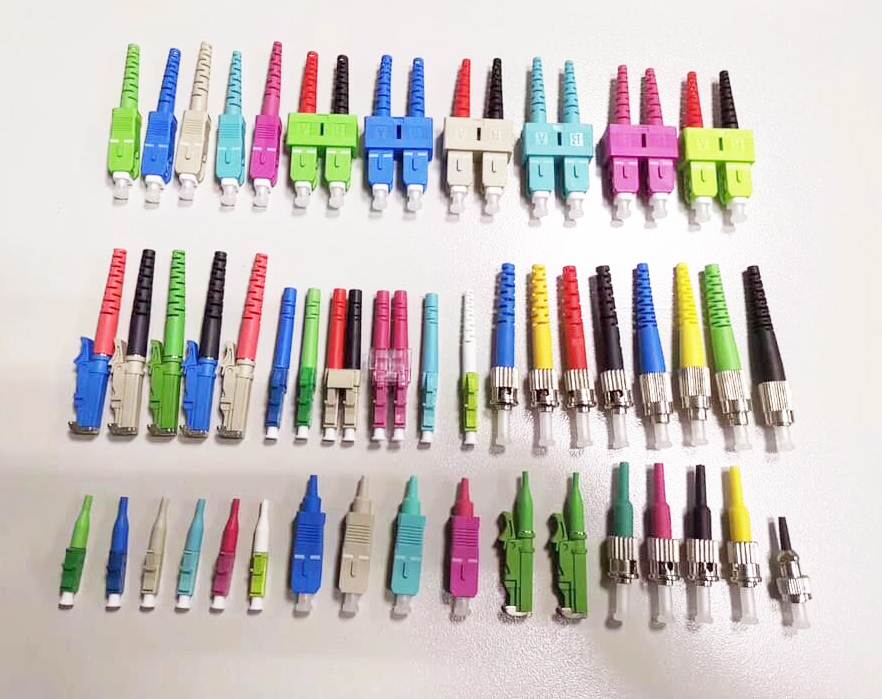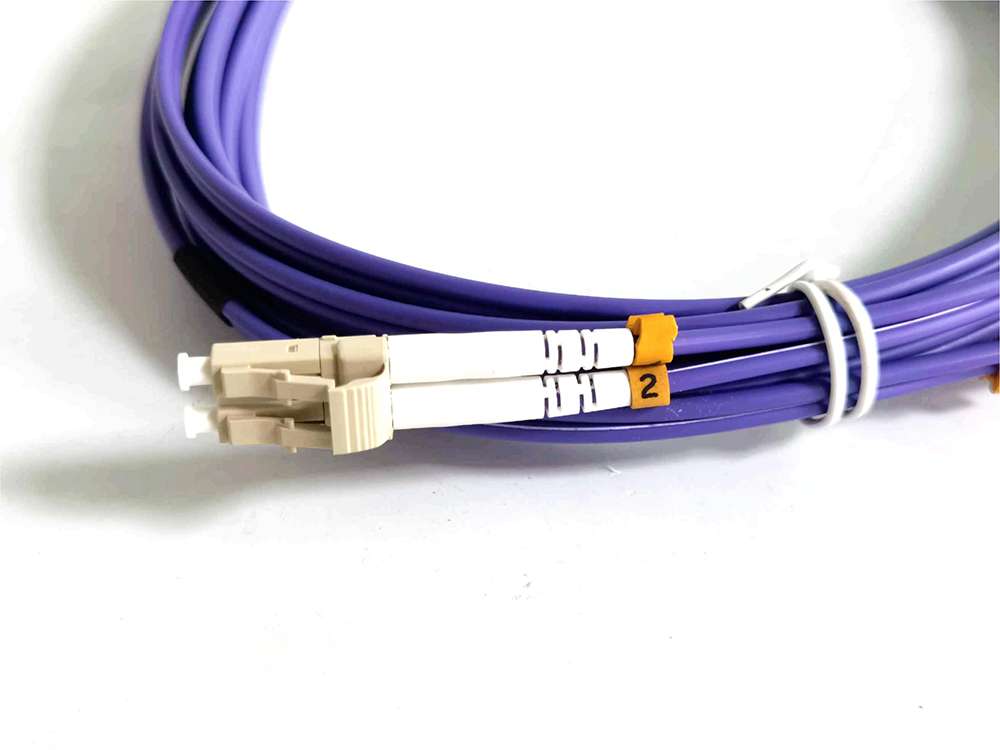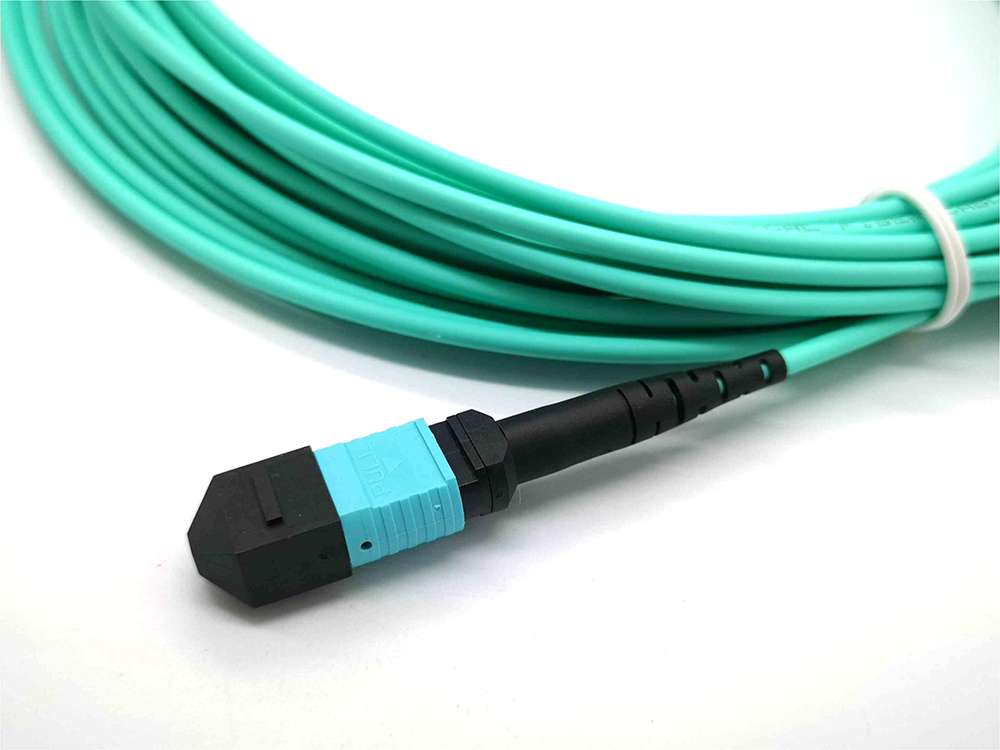Fiber optic connectors is a device that allows for detachable (movable) connections between optical fibers. It precisely connects the two end faces of the optical fiber to maximize the coupling of the optical energy output by the transmitting fiber to the receiving fiber, and minimize the impact on the system due to its involvement in the optical link. This is the basic requirement of ofc connectors. To a certain extent, fiber connector also affect the reliability and performance of optical transmission systems.
Fiber optic cable connectors can be divided into common single-mode and multi-mode connectors for silicon-based fibers based on different transmission media, as well as other ofc connectors that use plastic as the transmission medium; According to the structural form of the connector, it can be divided into various forms such as FC, SC, ST, LC, D4, DIN, MU, MT, E2000, MT-RJ, LX.5, FDDI, etc. Among them, ST connectors are usually used at the wiring equipment end, such as fiber optic distribution frames, fiber optic modules, etc; SC and MT connectors are typically used on the network device side. According to the shape of the fiber end face, there are PC (including SPC or UPC) and APC; There are also single core and multi-core (such as MT-RJ) classifications based on the number of fiber cores. Fiber cable connector are widely used and have a wide variety of varieties. In practical applications, we generally distinguish according to the different structures of optical fiber connectors.
What Are the types of fiber connectors?

Fiber optic connectors have many types and cannot be used interchangeably with each other. People who are not frequently exposed to optical fibers may mistakenly think that the fiber optic connectors of GBIC and SFP modules are the same, but in fact, they are not. The SFP module is connected to an LC connector, while the GBIC is connected to an SC connector. Below is a detailed explanation of several commonly used fiber connectors in network engineering:
FC Connector (Fiber Connector)
FC fiber connector were first developed by NTT in Japan, with external reinforcement using metal sleeves and fastening using screw buckles. The FC connector has a simple structure, convenient operation, and easy production, but the fiber end is more sensitive to fine dust and is prone to Fresnel reflection, making it difficult to improve the return loss performance. Later, improvements were made to this type of connector by using a spherical mating pin (PC), while the external structure remained unchanged, resulting in a significant improvement in insertion loss and return loss performance. FC optical connector are most commonly used on the ODF side of telecommunications networks, with a nut screwed onto the adapter. The advantages are reliability and dust resistance, but the disadvantage is that the installation time is slightly longer.

SC Connector (Standard Connector)
SC fiber connector is a fo cable connector developed by NTT Corporation in Japan. Its shell is rectangular, and the structural dimensions of the pins and coupling sleeves used are exactly the same as those of the FC type. The end face of the pin is often ground using PC or APC grinding methods; The size of the plug and sleeve is 2.5mm, which is twice that of LC. The fastening method adopts a plug-in pin latch type, without the need for rotation. sc connector fiber is inexpensive, easy to insert and remove, with small fluctuations in insertion loss, high compressive strength, and high installation density; The disadvantage is that it is easy to fall out.
SC connector is a connector for connecting GBIC optical modules, which is very convenient to use and is most commonly used on router switches.

ST Connector(Straight Tip)
Fiber ST connector is a mechanical connection method, with a circular shell and a fastening method of a screw buckle. After insertion, it rotates half a circle and is fixed with a snap. ST fiber connectors are commonly used in fiber optic distribution frames, but their disadvantage is that they are prone to breakage, causing damage to the connection points and affecting the quality of fiber optic communication. For 10Base-F connections, the connector is usually of the ST fiber.

LC connector (Lucent Connector)
LC fiber connector was developed by the renowned Bell Institute and is made using a modular jack (RJ) latch mechanism that is easy to operate. The size of the pins and sleeves used is half of the size used for ordinary SC, FC, etc., which is 1.25mm. LC connectors can increase the density offiber termination kit in the fiber optic distribution frame. At present, in single-mode SFF, LC fiber connectors have actually taken the dominant position, and their applications in multi-mode have also grown rapidly.

MT-RJ Connector (Mechanical Transfer Registered Jack)
MTRJ started with the development of NTT’s MT connector, which has the same latch mechanism as the RJ-45 LAN electrical connector. It aligns the optical fiber with guide pins installed on both sides of the small sleeve. In order to facilitate connection with the optical transceiver, the connector end face optical fiber is designed with a dual core (0.75mm interval) arrangement, and is the next generation of high-density optical fiber connectors mainly used for data transmission. MT-RJ integrated square connector with dual fiber transmission and reception at one end. The external components of the Mtrj connector are precision plastic parts, including a push-pull insertion and locking mechanism, suitable for indoor applications in telecommunications and data network systems. (useful on Huawei 8850). MT-RJ connectors are suitable for multimode optical fibers and are commonly used in fiber optic networks in local area networks and data centers. They are compact, high-density, and save space for fiber optic connections.

MU Connector (Miniature unit Coupling)
The MU connector is the world’s smallest single core fiber connector developed by NTT based on the most commonly used SC connector. The connector uses a 1.25mm diameter sleeve and a self retaining mechanism, which has the advantage of achieving high-density installation. NTT has developed the MU connector series using a 1.25mm diameter sleeve from MU. They have socket type connectors (MU-A series) for fiber optic cable connections; Bottom plate connectors with self retaining mechanisms (MU-B series) and simplified sockets (MU-SR series) for connecting LD/PD modules to plugs. With the rapid development of fiber optic networks towards larger bandwidth and capacity, and the widespread application of DWDM technology, the demand for MU connectors will also grow rapidly.

DIN47256 Connector
DIN connector is developed by Germany. The structural dimensions of the pins and coupling sleeves used in this connector are the same as those of the FC optical connectors, and the end face treatment adopts PC grinding method. Compared with FC connectos, MU fiber connector structure is more complex, and there are springs in the internal metal structure that control pressure, which can avoid damaging the end face due to excessive insertion pressure. In addition, the mechanical accuracy of this type of connector is high, so the intervention loss value is small.

MTP/MPO Connector
The MTP MPO connector stands out from other fiber optic connectors due to its unique design as a multi fiber connector. Unlike connectors such as SC or LC that typically accommodate a single fiber, MPO connectors combine multiple fibers into a single rectangular core. These connectors can accommodate 12 to 24 fibers, making them ideal for high bandwidth fiber parallel connections.

In order to accommodate multiple optical fibers within the plug, larger MTP connectors are required. This design allows for the simultaneous transmission of multiple data streams, making it ideal for applications that require high data capacity, such as 40G and 100G networks.
However, the complexity of MTP connector lies in their polarity and male female head configuration. The connector has a keying mechanism to ensure correct alignment and prevent accidental connections. The key up and key down directions refer to the position of the key on the connector, which must match the corresponding keyway on the adapter or socket. In addition, MPO MTP fiber connectors come in both male and female versions and must be paired correctly to successfully connect.
Although mtp optical connector are complex, they have significant advantages in high-density connections and efficient data transmission. They can handle multiple fibers in a single connector, reducing the amount of space required for connections, making them valuable in data centers and other space limited environments. In addition, the parallel transmission capability of fiber mpo connector can achieve higher bandwidth and faster data transfer rates.
How to identify a fiber connector?
In the labeling of fiber optic connectors, we often see “FC/PC”, “SC/PC”, etc., the meanings is like this:
- “/” The preceding part indicates the connector type, such as SC FC LC ST, etc.
- “/” The following indicates the ferrule polishing or grinding method, such as UPC, PC, APC, SPC, etc.
Sometimes will use “- “or “space” to describe the connector type, like SC-APC, SC APC, etc.
What is the difference between APC and UPC?
PC UPC APC is a ceramic ferrule end face grinding method, used in conjunction with various types of optical fibers.
“PC” is most widely used in the equipment of telecommunications operators, with a flat connector cross-section.
The attenuation of “UPC” is smaller than that of “PC”, and it is generally used for equipment with special needs. Some foreign manufacturers use FC/UPC for internal jumpers in ODF racks, mainly to improve the indicators of ODF equipment itself.
In addition, the “APC” model was more commonly used in broadcasting and early CATVs,. It adopts an 8-degree inclined end face, which can improve the quality of TV signals. The main reason is that TV signals are modulated by analog light. When the coupling surface of the joint is vertical, the reflected light returns along the original path. Due to the uneven distribution of optical fiber refractive index, it will return to the coupling surface again. Although the energy is small at this time, the analog signal cannot completely eliminate noise. Therefore, it is equivalent to adding a weak signal with time delay on the original clear signal, which is manifested as a ghost on the image. The inclination angle of the tail fiber headband can prevent the reflected light from returning along the original path. Generally, this problem does not exist in digital signals.
What is the difference between ST and FC fiber optic connector?
ST and FC are both metal connectors, which were commonly used in the early days. But there is a clear difference between the two types fiber optic connectors:
The ST interface uses a straight plug form, while the FC interface uses a threaded connection.
The ST connector is mostly used for multimode fibers, while the FC connector is mostly used for single-mode fibers.
In terms of connection, the ST connector is relatively simple and easy to use, while the FC connector is more stable and reliable.
What is the difference between LC and SC fiber optic connectors?
SC and LC are both plastic fiber optic connectors, and from the appearance, there are no metal accessories. And the appearance and size of the LC duplex connectors are the same as the SC, so in many cases, if LC duplex ports can be used, SC can be used. The difference between the SC LC connectors are in the following aspects:
1. The R&D manufacturers are different. SC is a fiber optic connector developed by NTT in Japan, while LC was developed by Bell Laboratory.
2. Different structure: SC adopts a plug-in pin latch type, which does not require rotation and can be directly inserted and pulled out. It has low fluctuation in connection loss, high compressive strength, and high installation density. LC is made with a modular jack (RJ) latch mechanism that is easy to operate.
3. Different sizes: The size of the SC plug and sleeve is 2.5mm, while the LC is 1.25mm, which is exactly half the size of the SC and can improve the density of the fiber optic connectors in the fiber optic distribution frame.
4. Different applications: SC is mainly used in GBIC optical modules, routers, and switches, while LC is more commonly used in high-density systems such as single-mode SFP modules and central computer rooms.
How to pack fiber connectors?
As a factory, Yingda will provide various models of fiber optic connectors, all of which are assembled with fiber optic cables as fiber pigtails and jumpers. Generally, if customers purchase and use fiber optic connectors directly after buying for their projects, or wholesalers, or distributors, they will not purchase them separately. At this time, the packaging method is to package according to the shape and size of the finished product, which can be bag packaging, reel packaging, or wrapped in plastic film. Products, connectors, cable length, cable color, cable diameter, material, packaging, labels… all can be custom.
However, with the development of optical communication, more and more clients are starting to establish their own jumper production workshops or production lines to meet the growing demand of the domestic fiber optic market. At this time, our company YINGDA can also provide various supporting production equipment and fiber optic connectors that customers need. The fiber optic connectors here usually undergo simple assembly, such as ferrule with stem, housing with main body, etc. Typically, 200 or 500 sets of loose parts are packaged in one package, and then packaged in a cardboard box before shipping to the customer. As shown in the figure below.

How to buy fiber optic connectors?
Due to the fact that connectors are distinguished by the size of the boot, which are 0.9mm, 2.0mm, and 3.0mm; At the same time, the types of optical fibers related to the connectors are different, and the ferrules used are different from UPC APC PC, so there is also a color differentiation along with the housing. So when ordering fiber optic connectors, it is important to pay attention to the following points:
| Connector type | FC SC LC ST DIN D4 E2000 MPO MTRJ MU, etc |
| Ferrule type | PC UPC APC |
| Fiber type | Single mode, multimode OM1 OM2 OM3 OM4 OM5 |
| Fiber count | Simplex, duplex |
| Cable diameter | 0.9mm, 1.6mm, 2.0mm, 2.4mm, 2.8mm, 3.0mm,3.5mm, 5mm, etc |
| Housing color | Black, red, blue, green, white, beige, aqua, purple, violet, etc |
| Boot color | Black, red, blue, green, white, beige, aqua, purple, violet, etc |

